Abstract
Studies of structure-activity relationships and molecular mechanisms of action are fundamental to our understanding of the harmful effects of chemicals on the environment and their more direct effects on human health. It is important to identify factors that determine toxicological effects of foreign chemicals in biological systems and to assess our knowledge about chemical mechanisms of toxicity. Several fundamental mechanisms underlying toxic action are described, and the importance of studying receptor-substrate interactions is stressed. The Ah receptor is cited as an example of a protein-small molecule interaction associated with extreme acute toxicity in laboratory animals. It is recognized that reliable attempts at predictive toxicology across compound classes through structural and theoretical chemistry approaches must be based on sound knowledge about mechanisms of action at the molecular level. Such studies also contribute to the knowledge base in biomedical and physical sciences.
Full text
PDF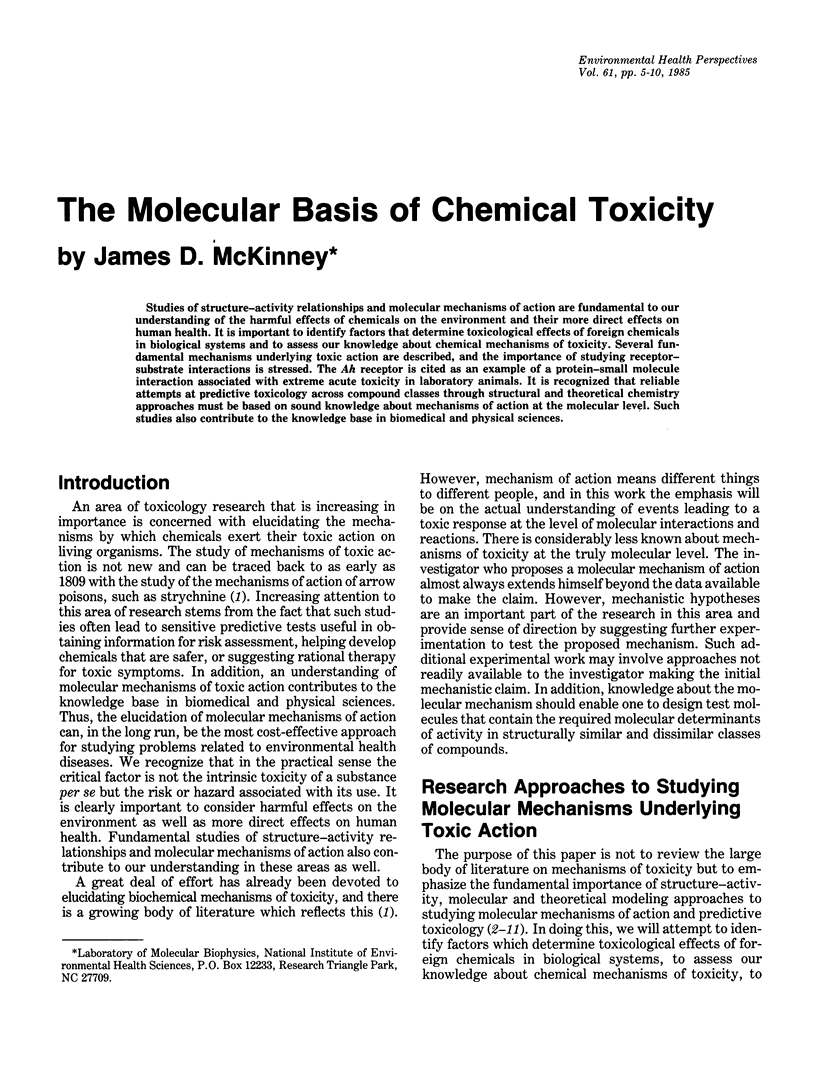
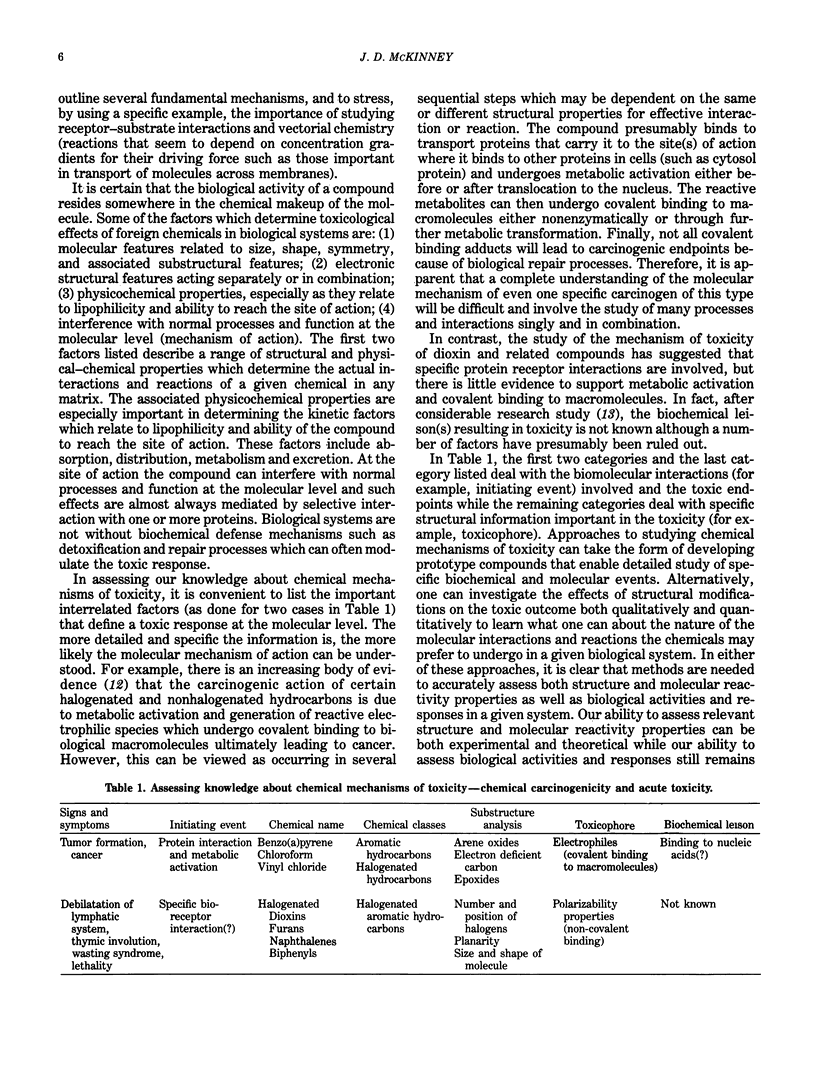
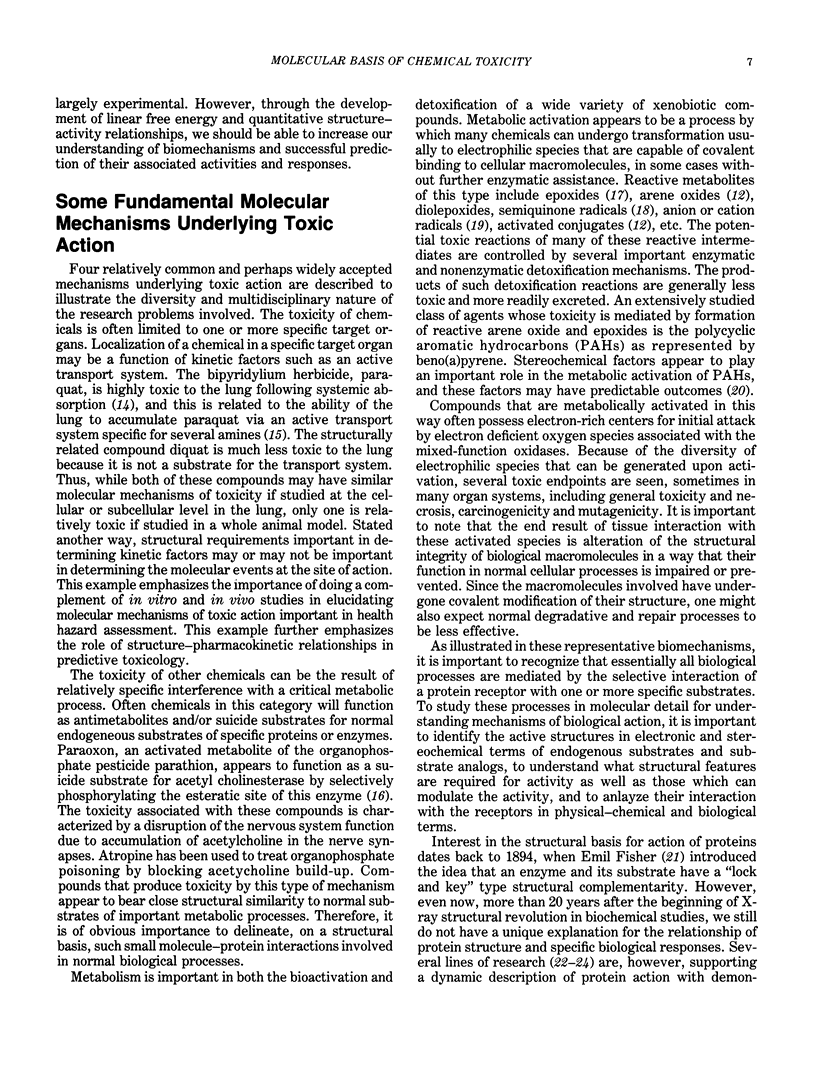
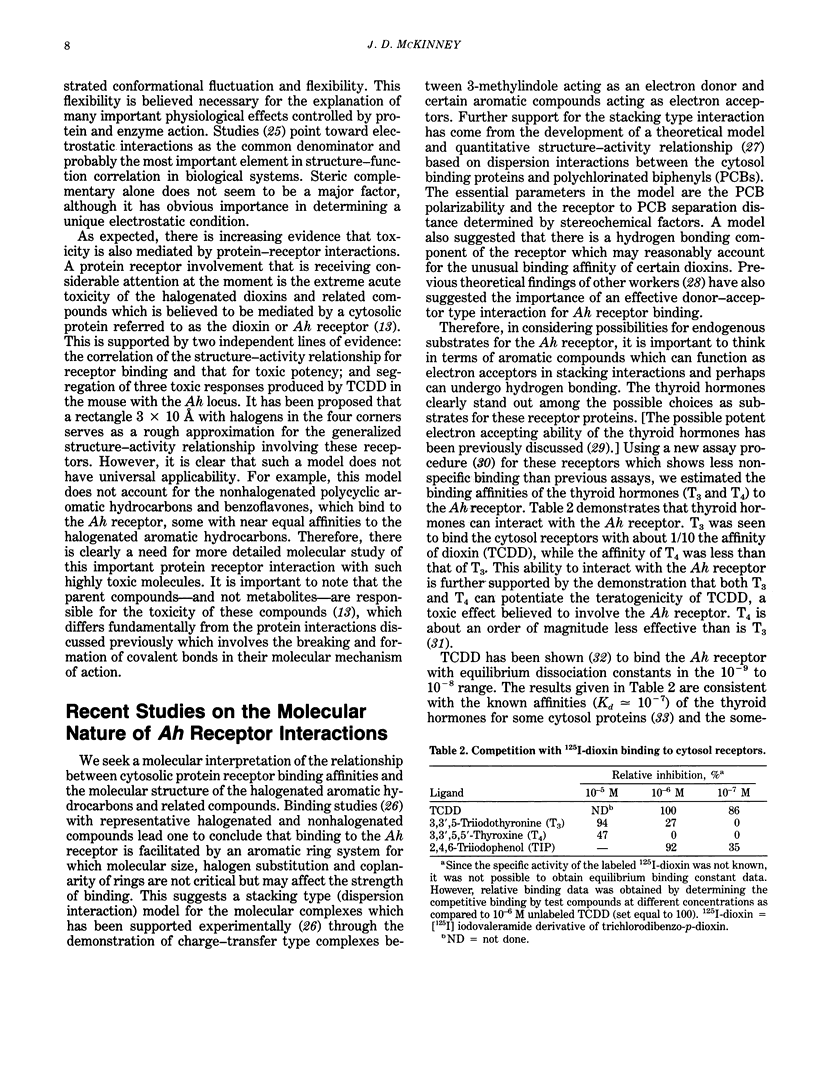
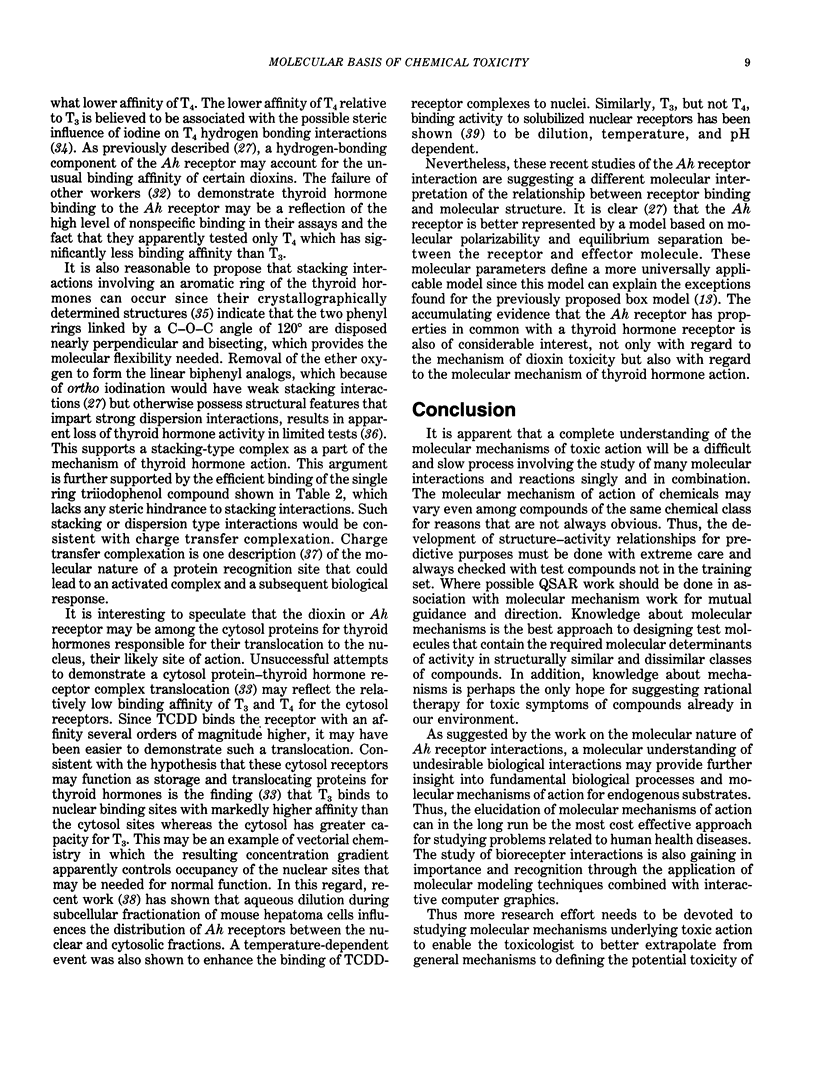
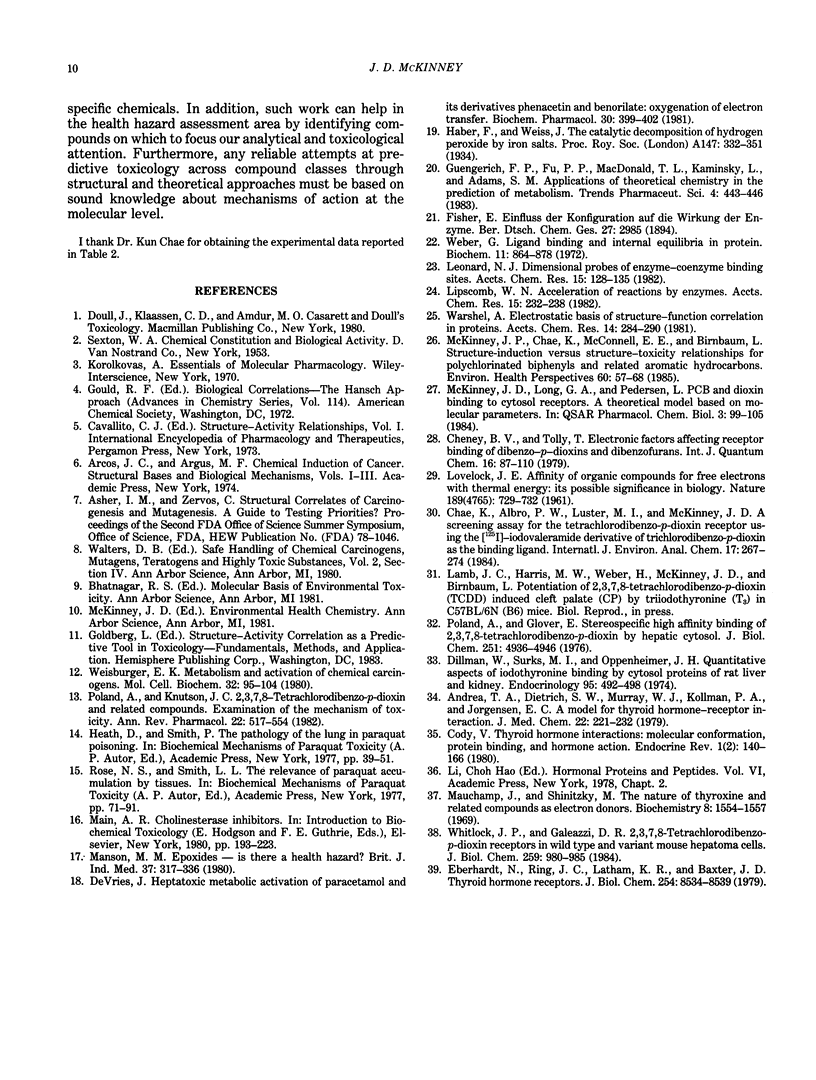
Selected References
These references are in PubMed. This may not be the complete list of references from this article.
- Andrea T. A., Dietrich S. W., Murray W. J., Kollman P. A., Jorgensen E. C., Rothenberg S. A model for thyroid hormone--receptor interactions. J Med Chem. 1979 Mar;22(3):221–232. doi: 10.1021/jm00189a002. [DOI] [PubMed] [Google Scholar]
- Chae K., Albro P. W., Luster M. I., McKinney J. D. A screening assay for the tetrachlorodibenzo-p-dioxin receptor using the [125I]iodovaleramide derivative of trichlorodibenzo-p-dioxin as the binding ligand. Int J Environ Anal Chem. 1984;17(3-4):267–274. doi: 10.1080/03067318408076978. [DOI] [PubMed] [Google Scholar]
- Cody V. Thyroid hormone interactions: molecular conformation, protein binding, and hormone action. Endocr Rev. 1980 Spring;1(2):140–166. doi: 10.1210/edrv-1-2-140. [DOI] [PubMed] [Google Scholar]
- Dillman W., Surks M. I., Oppenheimer J. H. Quantitative aspects of iodothyronine binding by cytosol proteins of rat liver and kidney. Endocrinology. 1974 Aug;95(2):492–498. doi: 10.1210/endo-95-2-492. [DOI] [PubMed] [Google Scholar]
- Eberhardt N. L., Ring J. C., Latham K. R., Baxter J. D. Thyroid hormone receptors. Alteration of hormone-binding specificity. J Biol Chem. 1979 Sep 10;254(17):8534–8539. [PubMed] [Google Scholar]
- LOVELOCK J. E. Affinity of organic compounds for free electrons with thermal energy: its possible significance in biology. Nature. 1961 Mar 4;189:729–732. doi: 10.1038/189729a0. [DOI] [PubMed] [Google Scholar]
- Manson M. M. Epoxides--is there a human health problem? Br J Ind Med. 1980 Nov;37(4):317–336. doi: 10.1136/oem.37.4.317. [DOI] [PMC free article] [PubMed] [Google Scholar]
- Mauchamp J., Shinitzky M. The nature of thyroxine and related compounds as electron donors. Biochemistry. 1969 Apr;8(4):1554–1557. doi: 10.1021/bi00832a034. [DOI] [PubMed] [Google Scholar]
- McKinney J. D., Chae K., McConnell E. E., Birnbaum L. S. Structure-induction versus structure-toxicity relationships for polychlorinated biphenyls and related aromatic hydrocarbons. Environ Health Perspect. 1985 May;60:57–68. doi: 10.1289/ehp.856057. [DOI] [PMC free article] [PubMed] [Google Scholar]
- Poland A., Glover E., Kende A. S. Stereospecific, high affinity binding of 2,3,7,8-tetrachlorodibenzo-p-dioxin by hepatic cytosol. Evidence that the binding species is receptor for induction of aryl hydrocarbon hydroxylase. J Biol Chem. 1976 Aug 25;251(16):4936–4946. [PubMed] [Google Scholar]
- Poland A., Knutson J. C. 2,3,7,8-tetrachlorodibenzo-p-dioxin and related halogenated aromatic hydrocarbons: examination of the mechanism of toxicity. Annu Rev Pharmacol Toxicol. 1982;22:517–554. doi: 10.1146/annurev.pa.22.040182.002505. [DOI] [PubMed] [Google Scholar]
- Weber G. Ligand binding and internal equilibria in proteins. Biochemistry. 1972 Feb 29;11(5):864–878. doi: 10.1021/bi00755a028. [DOI] [PubMed] [Google Scholar]
- Weisburger E. K. Metabolism and activation of chemical carcinogens. Mol Cell Biochem. 1980 Sep 15;32(2):95–104. doi: 10.1007/BF00227802. [DOI] [PubMed] [Google Scholar]
- Whitlock J. P., Jr, Galeazzi D. R. 2,3,7,8-Tetrachlorodibenzo-p-dioxin receptors in wild type and variant mouse hepatoma cells. Nuclear location and strength of nuclear binding. J Biol Chem. 1984 Jan 25;259(2):980–985. [PubMed] [Google Scholar]
- de Vries J. Hepatotoxic metabolic activation of paracetamol and its derivatives phenacetin and benorilate: oxygenation or electron transfer? Biochem Pharmacol. 1981 Mar 1;30(5):399–402. doi: 10.1016/0006-2952(81)90622-5. [DOI] [PubMed] [Google Scholar]


